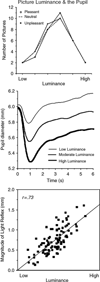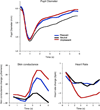The pupil as a measure of emotional arousal and autonomic activation
- PMID: 18282202
- PMCID: PMC3612940
- DOI: 10.1111/j.1469-8986.2008.00654.x
The pupil as a measure of emotional arousal and autonomic activation
Abstract
Pupil diameter was monitored during picture viewing to assess effects of hedonic valence and emotional arousal on pupillary responses. Autonomic activity (heart rate and skin conductance) was concurrently measured to determine whether pupillary changes are mediated by parasympathetic or sympathetic activation. Following an initial light reflex, pupillary changes were larger when viewing emotionally arousing pictures, regardless of whether these were pleasant or unpleasant. Pupillary changes during picture viewing covaried with skin conductance change, supporting the interpretation that sympathetic nervous system activity modulates these changes in the context of affective picture viewing. Taken together, the data provide strong support for the hypothesis that the pupil's response during affective picture viewing reflects emotional arousal associated with increased sympathetic activity.
Figures



References
-
- Aboyoun DC, Dabbs JM. The Hess pupil dilation findings: Sex or novelty? Social Behavior and Personality. 1998;26:415–420.
-
- Beatty J, Lucero-Wagoner B. The pupillary system. In: Cacioppo JT, Tassinary LG, Berntson GG, editors. Handbook of psychophysiology. Cambridge, UK: Cambridge University Press; 2000. pp. 14–162.
-
- Berntson GG, Boysen ST, Bauer HR, Torello MS. Conspecific screams and laughter: Cardiac and behavioral reactions of infant chimpanzees. Developmental Psychobiology. 1989;22:771–787. - PubMed
-
- Bradley MM, Codispoti M, Cuthbert BN, Lang PJ. Emotion and motivation I: Defensive and appetitive reactions in picture processing. Emotion. 2001;1:276–298. - PubMed
-
- Cook EW., III . VPM reference manual. Birmingham, Alabama: Author; 2001.
Publication types
MeSH terms
Grants and funding
LinkOut - more resources
Full Text Sources
Other Literature Sources

